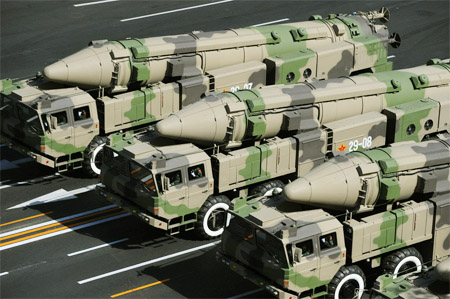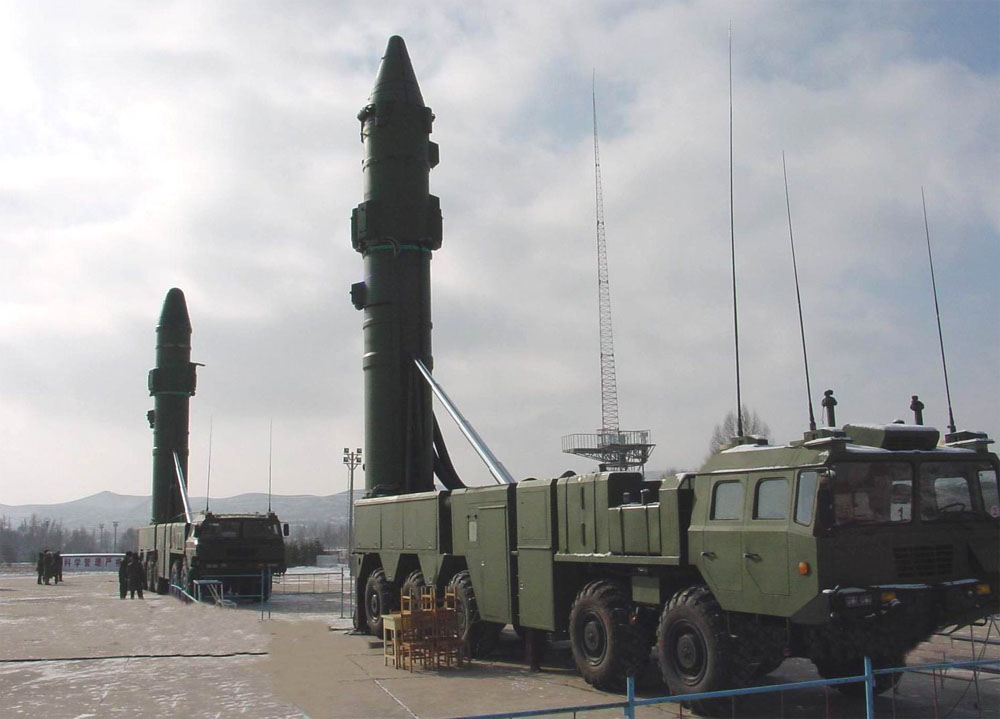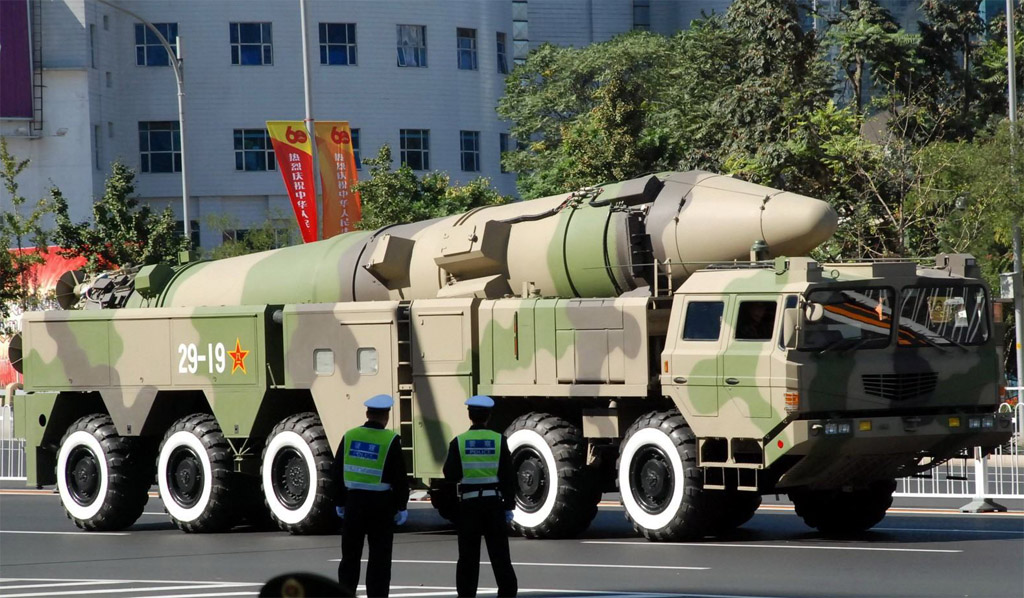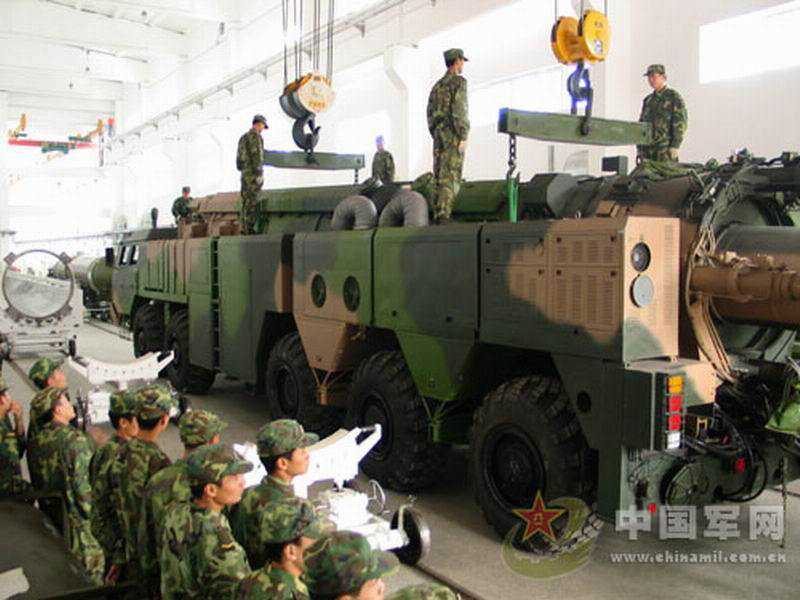| DongFeng 21C (CSS-5 Mod-3) Medium-Range Ballistic Missile
中国DF-21C(CSS-5 Mod-3)中程弹道导弹 Date:2013-10-26 Source:internet By:globalmil Viewed: |

The PLA Second Artillery Corps fielded a new type conventionally-armed, solid-propellant, mobile-launch medium-range ballistic missile (MRBM) in 2004~05. Carried and launched from a wheeled 10X10 transporter-erector-launcher (TEL) vehicle, the missile is believed to be capable of delivering a single and multiple conventional warheads weighing 2,000kg and have a maximum range of 1,700km.
2004~05年,PLA第二炮兵部署一种新型常规装备、固体推进剂、机动发射中程弹道导弹(MRBM)。从一辆轮式10X10运送-起竖-发射(TEL)车辆上携带并发射,导弹据信能够递送重量2,000公斤的单一或多重常规弹头,最大射程1,700公里。
Programme
An sketchy image of the new MRBM was first published anonymously on the Chinese Internet in November 2006, followed by a high-resolution photo showing two missiles with different warhead configurations published anonymously in July 2007. The PLA Daily website has also published a photo showing PLA Second Artillery Corps soldiers loading a missile onto a TEL vehicle exactly identical to that shown in previous photos, indicating that the missile system was already in operational use.
计划
在2006年11月新型MRBM的一张粗略图像被首次匿名发表在中国英特网上,接着在2007年7月一张高分辨率照片展示两种采用不同弹头构造的导弹被匿名发表在中国英特网上。中国人民解放军(PLA)日报网站也已经发表一张相片显示PLA第二炮兵军人装填一枚导弹到一辆TEL车辆上而且和过去在图片上显示的完全相同,标志导弹系统已经在操作服役中。

Two types of DongFeng 21C with different warheads in display (Chinese Internet)
两种型号DF-21C采用不同的弹头展示(中国英特网)
The exact designation of the missile is unknown. Some reports suggested that the missile might be the DF-25, a conventionally-armed MRBM developed in the late 1980s for export. With no further information on the missile emerging, Western intelligence concluded that the development was cancelled in 1996. However, the project may have been secretly kept alive and the missile was later adopted by the PLA for conventional roles. It is worth noting that this theory was not supported by the latest Pentagon report to the U.S. Congress on the PRC military power published in March 2008, with no mentioning of DF-25’s existence in the report.
导弹准确命名未知。一些报告认为导弹可能是DF-25,一种常规装备的MRBM在1980年后期用于外销被发展。关于导弹没有进一步的信息出现,西方情报得出结论发展在1996年被取消。然而,计划可能秘密地继续进行,而且导弹后来被PLA采用用于常规角色。值得注意的是这一个看法没有被五角大楼在2008年3月美国国会发表最新中国军事力量报告支持,DF-25存在没有在报告中提及。
A second theory is that the missile was an improved conventional version of the nuclear-armed DongFeng 21 MRAM, possibly with a designation DongFeng 21C (NATO reporting name: CSS-5 Mod-3). The two missiles share a similar range (~1,700km), but the DongFeng 21 only has a payload of 600kg, compared to the 2,000kg payload of the DongFeng 21C. The two systems bear no resemblance in appearance. Finally, some suggested that the missile was a totally new design derived by removing the third-stage from the three-stage DF-31 ICBM and substituting a modified second stage.
第二种看法导弹是核装备的DF-21 MRAM一种改进型,可能命名DF-21C(北约命名:CSS-5 Mod-3)。二种导弹具有同样射程(~1,700公里),但是与东风-21C的2,000公斤负载相比,DF-21仅仅负载600公斤。二种系统具有不相似的外观。最后,一些观点认为导弹是完全新设计两级弹道导弹,源于三级DF-31 ICBM将其第三级取消,并且对原第二级代以经改进的第二级。
Although the idea of using conventionally-armed ballistic missiles for tactical and strategic roles had been raised since the 1970s, the PRC had no conventional ballistic missile capability until the Second Artillery Corps added conventional strikes to its missions in the early 1990s. At the time of 1996 Taiwan Strait crisis, the PLA Second Artillery Corps had only deployed 30~50 short-range ballistic missiles (SRBM), but this number had increased to nearly 800 by 2007. The PRC Government outlined in its white paper China’s National Defence in 2006 that “the Second Artillery Force is striving to build a streamlined and effective strategic force with both nuclear and conventional capabilities”.
虽然使用常规装备弹道导弹用于战术和战略角色设想已经从1970年以后呈现,但是中国没有常规弹道导弹能力,直到在1990年早期第二炮兵把常规打击加入它的任务中。在1996年台海危机时,PLA第二炮兵仅仅部署30~50近程弹道导弹(SRBM),但是这一个数字2007年增加到将近800枚。2006年中国政府在中国国防白皮书中概略说明“第二炮兵力量正在努力建立精简和有效战略力量具有核和常规两者能力”。
The 1980s conflicts with Vietnam over the sovereign of the disputed Nansha (Spratly) Islands in the South China Sea made PRC military planners realise that the PLA was incapable of operating far from the country’s coasts due to its lack of long-range strike aircraft, aerial tanker, and aircraft carrier. However, this deficiency could be partially offset by short- to medium-range ballistic missiles, which could provide an ability to deliver conventional firepower quickly over extended distances.
在1980年同越南在南中国海南沙群岛的一些冲突,使中国军事规划者认识到中国由于缺乏远程打击飞机、空中加油机和航空母舰无法远离本国海岸行动。然而,这个不足可能部份地被短程弹道导弹抵销,可以提供一种能力递送常规火力快速对延伸距离覆盖。
Design
The DongFeng 21C was the second design of solid-propellant MRBM deployed by the PLA, after the DongFeng 21 that entered service in the late 1980s. The missile is mounted on a WS2500 wheeled 10X10 TEL vehicle, with a maximum load capacity of 28 tonnes. Reportedly developed under the assistance of Belarus and resembling the Russian MAZ543 missile TEL vehicle, the WS2500 shows strong off-road travelling ability.

DongFeng 21C TEL vehicle (Chinese Internet)
DF-21C TEL车辆(中国英特网)

PLA Second Artillery Corps crew loading a DongFeng 21C missile onto the TEL (PLA Daily)
PLA第二炮兵人员装载一枚DF-21C导弹到TEL上(PLA日报)
设计
DF-21C是继在1980年后期服役的DF-21之后被PLA部署的第二种固体推进设计的MRBM。导弹装在一辆WS2500型轮式10X10 TEL上,具有28吨的最大负载能力。据传闻在白俄罗斯的协助下发展而且类似俄国MAZ543导弹TEL车辆,WS2500显示强大的越野行进能力。
The missile is placed inside a cylinder-shape container/launcher, with its nose extending outside of the launcher. The missile container/launcher is in horizontal position when in travelling and vertical position during launch. At the bottom of the container/launcher there are four large hydraulically operated stabilisers, which are lowered in preparation for the missile launch.
导弹放置在一个圆筒形容器/发射器内,它的前端延伸出发射装置外面。导弹容器/发射器当行进时在水平位置和在发射期间处在垂直位置。在容器/发射器底部是四个大的液压操作稳定升降器,在导弹发射准备时降下。
It is now known that type of warheads the new MRBM is carrying, but it can be assumed that the possible options for the warhead may include high-explosive (HE), anti-armour submunitions, fuel air explosive (FAE), and electromagnetic pulse (EMP). Like the DF-11 and DF-15 SRBMs, the new MRBM is likely to be equipped with a combined inertial/GPS guidance system, possibly coupled with terminal guidance for increased accuracy.
目前了解新的MRBM携带弹头的类型,但是它能被假定弹头可能选项包括高爆(HE)、反装甲弹药、燃料空爆(FAE)和电磁脉冲(EMP)。像DF-11和DF-15 SRBM,新的MRBM能装备组合惯性/GPS导航系统,可能外加末端制导用于增强精度。
Last update: 3 October 2009
最后更新:2009年10月3日
上一篇:DongFeng 21 (CSS-5) Medium-Range Ballistic Missile 下一篇:DongFeng 15 (CSS-6) Short-Range Ballistic Missile
| DF-1 ballistic missile system
中国东风-1(DF-1)弹道导弹系统 |
| China’s first ballistic missile system, a licensed copy of the Soviet R-2 (SS-2 ‘Sibling’) short-range ballistic missile.... [2020-04-05] |
| B611 TACTICAL SURFACE-TO-SURFACE BALLISTIC MISSILE
中国B611战术地对地弹道导弹 |
| The B611 is the solid-fuel, surface-to-surface, short-range ballistic missile (SRBM) jointly developed by China Aerospace Science & Industry Corporation (CASIC) and Turkish weapon manufacturer MKEK.... [2017-01-15] |
| DF-21/A/C(CSS-5 Mod1/2/3)medium-range ballistic missile
中国东风-21/A/C型中程弹道导弹 |
| The DF-21 is a two-stage, solid-fuel rocket, single-warhead medium-range ballistic missile (MRBM) in the Dong Feng series developed by China Changfeng Mechanics and Electronics Technology Academy.... [2016-08-17] |
| DongFeng 31A (CSS-9 Mod-2) Intercontinental Ballistic Missil
中国DF-31A(CSS-9 Mod-2)洲际弹道导弹 |
| The DongFeng 31A (NATO reporting name: CSS-9 Mod-2) is a road-mobile, three-stage, solid-propellant intercontinental ballistic missile (ICBM), designed to carry a single 1,000kT thermal nuclear warhead.... [2016-01-04] |
